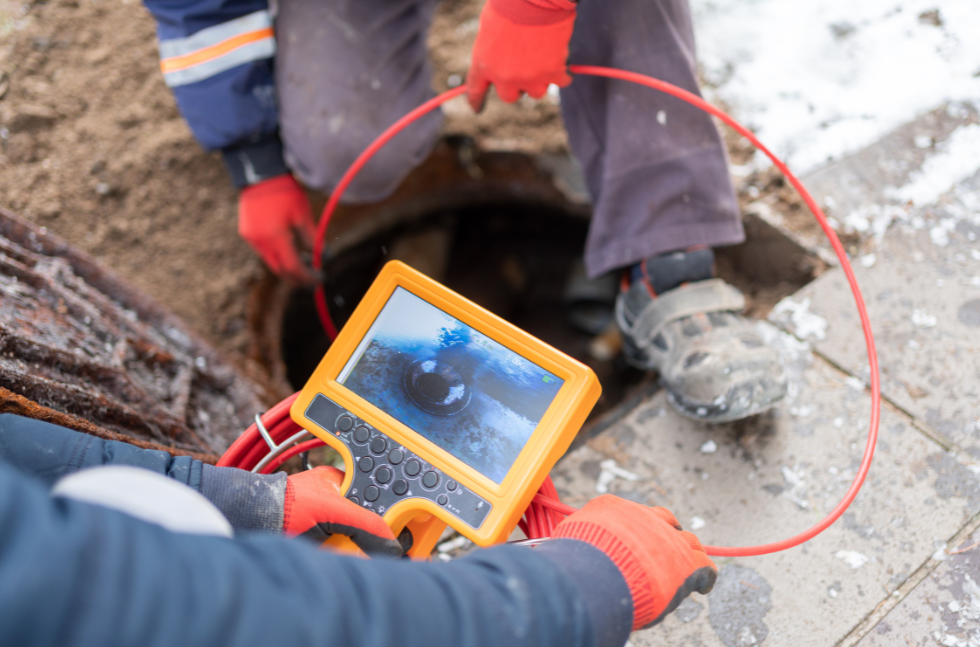Finding hidden problems in plumbing and HVAC systems can be tough and sometimes needs expensive and disruptive methods to investigate. If you don’t have the proper tools, small problems might not get noticed until they become big emergencies.
Inspection cameras are among the most helpful tools in plumbing maintenance. They allow plumbers to view inside systems without invasive techniques, resolving plumbing issues more quickly and accurately. Proper use and maintenance of these cameras can simplify the detection and resolution of potential plumbing issues.
Don’t let small problems turn into major repairs. Call R.S. Andrews today at (470) 264-8128 and talk to our inspection camera experts in Atlanta, Georgia.
In this guide, explore how inspection cameras can change how we maintain and repair our homes. Learn how these advanced tools can help you find and fix hidden plumbing problems quickly.

Inspection Cameras 101
Inspection cameras have changed the way plumbers check pipes and sewers. They make it easier to spot problems without digging up the ground or breaking walls. These tools let plumbers look deep inside pipes, find issues quickly, and fix them faster. Plus, they help plan for future maintenance better.
Here are other reasons why plumbers rely so heavily on inspection cameras:
Enhanced Diagnostic Accuracy
With inspection cameras, plumbers can directly observe the condition of pipes and other plumbing fixtures in real time. This allows for accurately diagnosing problems such as leaks, blockages, and damage without requiring extensive excavation or dismantling.
By seeing exactly what’s happening inside the pipes, plumbers can more precisely locate the source of a problem. This is less time-consuming and more cost-effective than traditional methods.
Preventive Maintenance
Regular camera inspections can show early signs of pipe corrosion, buildup, cracks, and other structural weaknesses. Addressing these issues early can prevent costly repairs and extensive damage to a plumbing system.
Minimal Invasion
Traditionally, plumbing issues could require digging up lawns, breaking through walls, or removing other structural components just to examine the pipes. Inspection cameras eliminate the need for such invasive procedures.
Improved Transparency
When plumbers use inspection cameras, they can show customers the exact nature of the problem. Customers appreciate seeing the issue for themselves rather than just taking a professional’s word for it. This transparency can improve customer satisfaction, repeat business, and positive reviews.
Saving Time and Costs
Inspection cameras speed up the diagnostic process as plumbers can quickly identify and locate issues. This then reduces the labor time and costs associated with guesswork and unnecessary repairs. This not only saves money for both the plumber and the customer but also allows plumbers to handle more jobs in less time.
Basic Components of Inspection Cameras
Knowing the basics of inspection cameras is important for using them effectively. These cameras have key parts that work together to capture images and videos in hard-to-reach areas.
Here’s an overview of their basic components:
Camera Head
The camera head is the main visual part of the device. It’s quite small and sits on the end of a long, flexible cable. This camera is designed to fit into narrow spaces and provides a video feed of areas that are otherwise difficult to see. It usually includes built-in lights to brighten dark spaces to ensure clear visibility.
Flexible Cable
The flexible cable connects the camera head to the main unit where the display is located. It is made to be strong yet flexible enough to navigate through tight bends and corners without damaging the camera or the cable. Depending on its intended use, the length of the cable can vary, with some being over 100 feet long.
Monitor/Display Unit
This part displays what the camera head sees. It allows the user to watch the video feed live. Displays vary in size; some may include touchscreens or options to record videos and take pictures for reviewing later.
Control Unit
Usually part of the monitor, the control unit includes buttons or controls to operate the camera head. You can use it to move the camera, adjust the lights, or change the focus and zoom to see better. Some advanced cameras have features that keep the video upright or alert you to specific conditions with special signals.
Power Source
Inspection cameras can be powered by batteries or plugged into a power source. Portable versions typically have rechargeable batteries, allowing them to be used in places without easy access to electrical outlets. The battery’s longevity is important for those who need to use the camera for long periods.
Accessories
Many inspection cameras come with extra tools to increase their usefulness. These could include various camera heads for different situations, hooks or magnets for grabbing objects, and protective cases. These could also include gadgets for remotely tracking the camera head’s location.
When do plumbers use inspection cameras?
Plumbers turn to inspection cameras as a go-to tool in several scenarios. Here are some common situations when a plumber might use an inspection camera:
- Identifying Blockages and Clogs: Whether it’s a blocked sewer line or a clogged drain, inspection cameras can provide a clear view of the problem without the need to cut into pipes or dig up your yard.
- Inspecting Pipes for Damage: Over time, pipes can suffer from various issues like cracks, corrosion, or misalignment. With an inspection camera, plumbers can inspect these pipes closely to understand the extent of the damage. They then plan the best repair strategy.
- Preventative Maintenance Checks: To avoid future plumbing disasters, regular inspections with a camera can help detect early signs of trouble, like small leaks or buildup, that might not be obvious otherwise.
- During Renovations: If you’re renovating your home, a plumber might use an inspection camera to check the condition of hidden pipes. This ensures they are in good shape before any work begins.
By using these cameras, plumbers can quickly and accurately assess the situation, leading to faster and less invasive repairs. This not only saves time and money but also spares your property from unnecessary damage.

